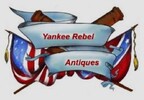 Loading... Please wait...
Loading... Please wait...-
Call us on (973) 810-2976
- My Account
- Gift Certificates
- Items / $0.00
Categories
- Home
- Sold, Hold, Layaway items
- RARE – Original pair of War of 1812 Black Mourning Shoe Buckles (ON HOLD)
RARE – Original pair of War of 1812 Black Mourning Shoe Buckles (ON HOLD)
Out of Stock
Product Description
This is another early piece coming out of a 60-year collection of French & Indian War, Revolutionary War, and War of 1812 artifacts. Being offered is a very rare pair of War of 1812 Shoe Mourning Buckles. The fancy buckles have black leather inserts and each measures 2 ½” x 1 ¾”. Shoe buckles such as this were worn by both American and England.
Shoe buckles came into fashion for men in the middle of the 17th century. They were used almost exclusively until 1790 when the French Revolution brought about a shift towards less ostentation in daily dress. However, shoes were not sold with buckles already attached, they had to be purchased separately.
During the 18th century, buckle making was a large trade in England, according to Chambers’ Encyclopedia: A Dictionary of Universal Knowledge, Volume II: “In the latter half of the 18th century the manufacture of buckles was carried on most extensively in Birmingham, there being at one time not less than 4000 people directly employed in that town and its vicinity, who turned out 2,500,000 pairs of buckles annually, the prices ranged from one shilling to five guineas, and even ten guineas a pair.”
These buckles were made from a variety of metals; silver, brass, iron, steel, copper, and pewter were common choices, and could be plain or very flashy incorporating real or paste gemstones, commemorative motifs, or pleasing designs. One could easily change the look of an average shoe by giving it a good blacking and putting an eye-catching buckle on it. When the buckle is set onto the shoe, everything but the rim (which some call the frame) is hidden by the buckle straps.
Shoe buckles were a sign of prestige and wealth, different buckles were used for everyday use, celebrations, weddings, politicians, and even for funerals, such as the ones being offered here. Mourning shoe buckles are very rare, and this is the only pair I have seen in many years.
They are in excellent condition and on the inside is a “L” for left and an “R” for the right shoe. Examples can be found in the “Collectors Illustrated Encyclopedia of the American Revolution” and in Colonial Williamsburg (see pictures).
This collection began in the late 1950s and was created by private acquisitions, closed museums, and lake divers. The collector meticulously displayed and cataloged every piece along with any known provenance and this is the first time this pair has been on the open market. It definitely merits a place in an advanced collection or museum.
As with all the pieces in this esteemed collection, a Certificate of Authenticity will be included. They come in the glass top display case pictured.



